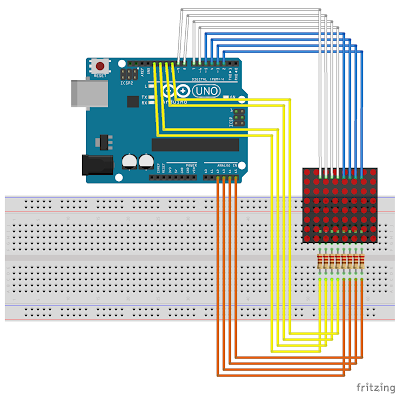Tocar música do mário no arduino O esquema é o seguinte: Aqui a programação: ↡↡↡↙↙↓↓↡↡⇩⇩⇟⇓⇙⇙⇘⇘⇊ /* Arduino Mario Bros Tunes With Piezo Buzzer and PWM Connect the positive side of the Buzzer to pin 3,4, then the negative side to a 1k ohm resistor. Connect the other side of the 1 k ohm resistor to ground(GND) pin on the Arduino. by: Gaspar Pereira last updated: 29/6/17 */ /_________________________________________________»»»» * Mario song _________________________________________________»»»» #define NOTE_B0 31 #define NOTE_C1 33 #define NOTE_CS1 35 #define NOTE_D1 37...
Mensagens
- Obter link
- X
- Outras aplicações
Hoje vamos trabalhar com DFPlayer módulo mp3 Aqui o esquema: Onde pode ser comprado: comprar no Ebay Aqui a programação:↓↓↓⇩⇩⇟⇟⇓⇓⇊⇊⇊↴↴↯↯ // Criado por Gaspar Pereira// #include <SoftwareSerial.h> #include <DFPlayer_Mini_Mp3.h> SoftwareSerial mySerial(10, 11); // RX, TX void setup () { Serial.begin (9600); mySerial.begin (9600); mp3_set_serial (mySerial); //set softwareSerial for DFPlayer-mini mp3 module delay(10); // delay 1ms to set volume mp3_reset(); delay(1000); mp3_set_volume (10); // value 0~30 delay(10); } void loop () { if (Serial.available()) { char command = Serial.read(); switch (command) { case ‘S’: mp3_stop(); delay(10); break; case ‘N’: mp3_next(); delay(10); break; case ‘P’: mp3_prev(); delay(10); break; } } }
- Obter link
- X
- Outras aplicações
Hoje vamos trabalhar com o sensor ultrassónico O esquema é o seguinte : ↓↓↓↓↓↓↙↙↙↧↧↧ 😊😊 Aqui a programação : #define PIN_TRIG 3 #define PIN_ECO 2 void setup() { // Inicializacion de la comunicacion serial Serial.begin (9600); // Inicializacion de pines digitales pinMode(PIN_TRIG, OUTPUT); pinMode(PIN_ECO, INPUT); } void loop() { long duracion, distancia; // Variables /* Fazer o disparo */ digitalWrite(PIN_TRIG, LOW); delayMicroseconds(2); digitalWrite(PIN_TRIG, HIGH); delayMicroseconds(10); digitalWrite(PIN_TRIG, LOW); /* Recepcion del eco de respuesta */ duracion = pulseIn(PIN_ECO, HIGH); /* Calculo de la distancia efectiva */ dista...
Ligar um teclado ao arduino
- Obter link
- X
- Outras aplicações
Ligar um teclado ao arduino e acender leds Para a programação FUNCIONAR têm que baixar a livraria PS2keyboard O esquema é o seguinte: e aqui a programação: #include <PS2Keyboard.h> /* PS2Keyboard library example PS2Keyboard now requries both pins specified for begin() keyboard.begin(data_pin, irq_pin); Valid irq pins: Arduino Uno: 2, 3 Arduino Due: All pins, except 13 (LED) Arduino Mega: 2, 3, 18, 19, 20, 21 for more information you can read the original wiki in arduino.cc at http://arduinogasparpf.blogspot.pt/2017/06/ligar-um-teclado-ao-arduino.html Like the Original library and example this is under LGPL license. Modified by Gaspar Pereira on 2017-06-10 Modified by gaspar.1...
- Obter link
- X
- Outras aplicações

Hoje vou trabalhar com Dot matrix 8x8 Aqui as ligações A programação é a seguinte ⇊⇊⇊⇊ Para desenhar corações; // 2-dimensional array of row pin numbers: const int row[8] = { 2, 7, 19, 5, 13, 18, 12, 16 }; // 2-dimensional array of column pin numbers: const int col[8] = { 6, 11, 10, 3, 17, 4, 8, 9 }; // 2-dimensional array of pixels: int pixels[8][8]; int count = 1000; char str[] = "FABCDEDCBA"; int strLen = sizeof(str); int ptrChar = 0; typedef bool charMapType[8][8]; const charMapType charBlank = { {0, 0, 0, 0, 0, 0, 0, 0}, {0, 0, 0, 0, 0, 0, 0, 0}, {0, 0, 0, 0, 0, 0, 0, 0}, {0, 0, 0, 0, 0, 0, 0, 0}, {0, 0, 0, 0, 0, 0, 0, 0}, {0, 0, 0, 0, 0, 0, 0, 0}, {0, 0, 0, 0, 0, 0, 0, 0}, {0, 0, 0, 0, 0, 0, 0, 0} }; const charMapType heart0 = { {0, 0, 0, 0, 0, 0, 0, 0}, {0, 0, 0, 0, 0, 0, 0, 0}, {0, 0, 0, 0, 0, 0, 0, 0}, {0, 0, 0, 0, 0, 0, 0, 0}, ...
- Obter link
- X
- Outras aplicações
Hoje vou trabalhar com o sensor DHT11 no arduino uno ou mega. Aqui vai o esquema ↓↓↓ Para a programação funcionar corretamente têm de baixar a bliblioteca DHT : no programa do arduino IDE vão a rascunho,incluir biblioteca, e pesquisão DHT11 A progamação é esta // Feito por GASPAR PEREIRA // // gaspar.10pereira@gmail.com // // SENSOR DHT11 // // leitura em monitor de série // #include <SimpleDHT.h> // for DHT11, // VCC: 5V or 3V // // GND: GND // // DATA: 4 // int pinDHT11 = 4; SimpleDHT11 dht11; void setup() { Serial.begin(115200); } void loop() { // start working... Serial.println("__________________________________"); Serial.println(" A ler sensor DHT11......"); // read without samples. byte temperature = 0; byte humidity = 0; if (d...